2.1 Customizing the GroupWise Interface
You can select to customize the look and feel of GroupWise in many different ways.
2.1.1 Selecting a GroupWise Scheme
You can select from four schemes:
-
Default: The Default scheme has a new color scheme and displays the Nav Bar, Full Folder List, the Main Menu, and two columns with panels.
-
GroupWise 6.5: The GroupWise 6.5 scheme has the Folder List, Main Toolbar, and Item List displaying in the old colors.
-
Simplified: The Simplified scheme has a new color scheme and has the Nav Bar, Simple Folder List, and two columns with panels.
-
Custom: The Custom scheme allows you to set the appearance settings however you like. If you edit one of the predefined schemes, those settings become your Custom scheme.
To select a scheme:
-
Click > .
-
Double-click , then click the tab.
-
Select a scheme from the drop-down list.
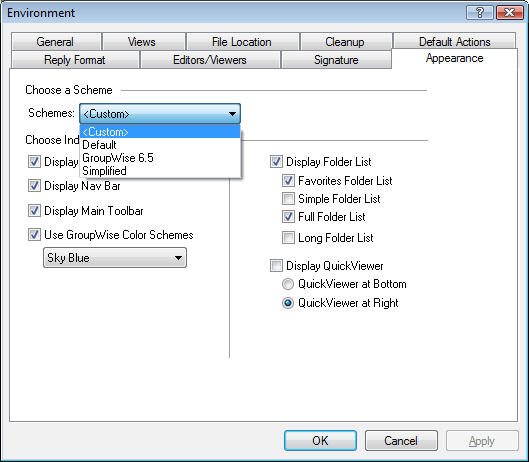
-
Click , then click .
2.1.2 Customizing Individual GroupWise Appearance Settings
There are several ways to change the GroupWise appearance.
-
Click > .
-
Double-click , then click the tab.
-
Select the appearance settings you want for GroupWise.
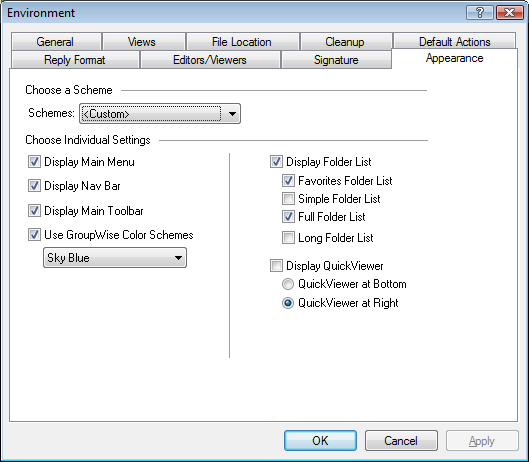
Schemes: See Section 2.1.1, Selecting a GroupWise Scheme.
Display Main Menu: Displays the Main Menu above the Nav Bar.
Display Nav Bar: Displays the Nav Bar for quick access to your most used folders.
Display Main Toolbar Displays the Main Toolbar for quick access to your most common functions.
Use GroupWise Color Schemes: Overrides any operating system color schemes for the selected GroupWise color scheme.
Display Folder List: Displays the Folder List on the left side of the window.
Favorites Folder List: Displays a customized list of folders. Folders in this list are displayed in the order that they are most commonly accessed.
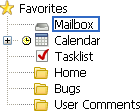
Simple Folder List: Displays only the folders that relate to the folder you are in. For example, if you are in your Mailbox folder, it displays the Cabinet folder so that you can file messages.

If you are in the Calendar folder, it lists personal calendars. If you are in the Frequent Contacts folder, it lists personal Contacts folders. If you are in the Documents folder, it lists documents.
Full Folder List: Displays the complete list of folders.
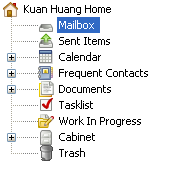
Long Folder List: If the QuickViewer is displayed, select this option to extend the Folder List to the bottom of the QuickViewer when it is displayed below the Item List rather than to the right.
Display QuickViewer: Select this option to display the QuickViewer, or leave it deselected to prevent the QuickViewer from displaying.
You can also customize individual folders for QuickViewer display. Right-click a folder, then click . Select or deselect and as needed.
QuickViewer at Bottom: If is selected, this option displays the QuickViewer at the bottom of the window.
QuickViewer at Right: If is selected, this option displays the QuickViewer at the right of the window.
-
Click .
2.1.3 Customizing the Main Toolbar
You can customize each toolbar by adding and deleting buttons, choosing button order, and placing separators between buttons.
-
To customize the Main toolbar if the toolbar is not displayed, right-click the toolbar, then click .
-
Click the tab.
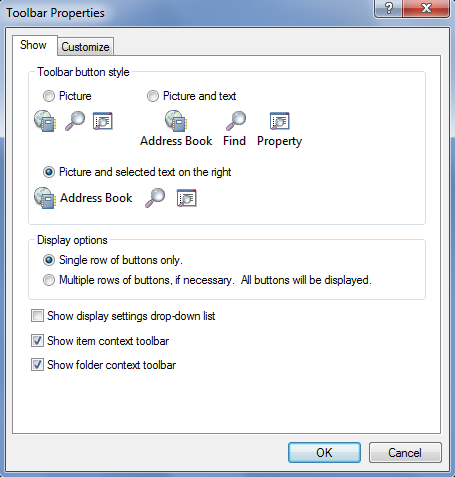
-
Click how you want the toolbar to display.
You can select to show buttons as pictures, pictures with text below them, or pictures with selected text on the right.
-
Select if you want a single row of buttons, or multiple rows of buttons if necessary.
-
To remove or show the display settings drop-down list, deselect or select the .
-
To show the buttons that are most useful for the selected item, select .
-
To show the buttons that are most useful for the selected folder, select .
-
Click the tab.
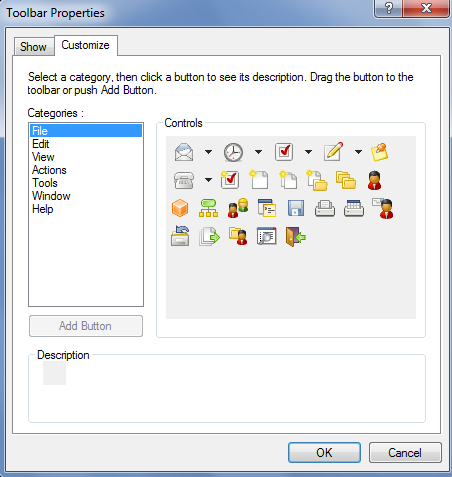
-
To add a button, click a category from the list box, click a button in the box, then click .
Categories are menu titles in the Main Window. The buttons in the box correspond to features found under the menu title. For example, the buttons for the File category are actions under the menu (opening views, printing, saving, and so on).
-
To remove a button, drag it off the toolbar
-
To change the order of a button on a toolbar, drag it to where you want it to display.
-
To add space between buttons, drag one button away from the other button.
or
To remove space between buttons, drag one button toward another button.
-
Click .
2.1.4 Setting Your Default Start Folder
By default, GroupWise displays your Mailbox folder. After you set up your Home folder, you might prefer to start in your Home folder instead.
-
Click > , then double-click .
-
Click the tab.
-
Select if you want to start GroupWise in the or .
-
Click .
2.1.5 Setting Default Views for Reading
Use this option to speed up load time when a user has added extra graphics and images, like backgrounds and signatures, to his or her default view. This option eliminates the added features and shows a default message.
This option does not modify changes such as font or size in the sent messages, unless the changes were actually saved as part of the view.
-
Click > .
-
Double-click .
-
Click the tab.
-
Select .
2.1.6 Setting the Default Read/Compose View and Font
To change the view for all items:
-
Click > .
-
Double-click .
-
Click the tab.
-
Make selections in the and group boxes.
-
(Optional) In the group box, select next to if you want to prevent HTML-only messages from being displayed when no plain text version is available.
If you select , a message informs you whenever an HTML-only message cannot be displayed; however, you can still click > to view it. If you do not select , HTML-only messages are displayed in HTML, even though you have selected for the default read view.
-
Select a default font style.
-
Select a default font size.
-
Click .
To change the view in one item:
-
Open an item.
-
Click , then click or .
2.1.7 Setting the QuickViewer Default Behavior
-
Click > , then double-click .
-
Click the tab.
-
Select if you want the QuickViewer to display on , , or .
-
Click .
2.1.8 Changing Your Default Item Views
-
Click > .
-
Double-click , then click the tab.
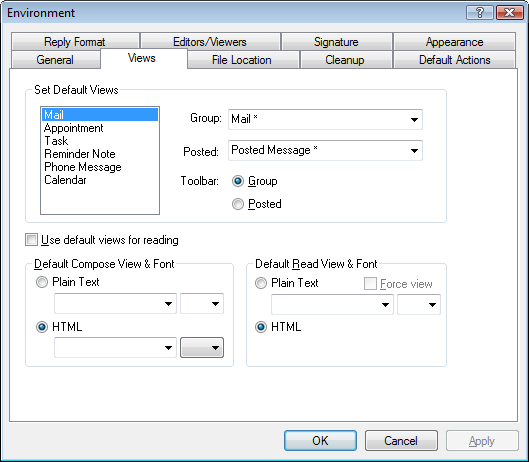
-
Select an item type from the box on the left.
-
Select the group setting in the Group drop-down menu.
-
Select the posted setting from the Posted drop-down menu.
-
Select or .
-
Repeat Step 3 through Step 6 until you have selected a default view for each item type.
-
Click .
2.1.9 Automatically Reading the Next Item in Your Mailbox
You can configure GroupWise to automatically open the next item in your mailbox after you accept, decline, or delete the item you are reading. By default, this option is disabled.
-
Click .
-
Double-click , then click the tab.
-
Select , then click .
2.1.10 Changing the GroupWise Interface Language
If you have the multilanguage version of GroupWise, you can select the interface language for GroupWise.
-
Click > .
-
Double-click , then click the tab.
-
Click a language in the drop-down list, then click .
HINT:To change the Spell Checker language, see Selecting the Spell Checker Language.